10 Iconic Goth Music Bands Shaping the Genre's Legacy
Share
Overview
Dive into the shadows as we explore the impact of ten iconic goth music bands that have etched their legacy into the very fabric of the genre. Bands like Bauhaus, Siouxsie and the Banshees, and The Cure have not just crafted the haunting soundscapes and dark aesthetics of goth music; they’ve ignited a cultural wildfire. These artists weave a tapestry of identity and the darker facets of human experience, forging an unbreakable bond between music and the soul. Are you ready to uncover the echoes of their influence?
Introduction
Goth music—a tempest of melancholy, rebellion, and artistry—has long shaped cultural landscapes. Its evolution is marked by iconic bands that leave indelible marks, influencing not just music, but fashion, art, and lifestyle. What is it about these bands that draws us in, igniting a spark of fascination?
Dive into the shadows as we explore ten seminal goth music bands, each a thread in the rich tapestry of contemporary culture. Their unique sounds and haunting aesthetics weave a legacy that resonates deeply.
Are you ready to uncover the allure that captivates audiences and inspires new generations to embrace the darkness?
Darc Arts: Elevating Cannabis Culture with Gothic Elegance
Darc Arts embodies the intoxicating fusion of cannabis culture and dark elegance. It offers premium THCA products that resonate with the gothic spirit, inviting you to indulge in a richer, more artistic experience. Sophistication drips from every corner, beckoning you to explore the depths of this unique lifestyle.
With the global cannabis market projected to soar to USD 65.54 billion by 2032, the appetite for high-quality, non-psychoactive treasures like THCA is intensifying—especially among niche markets. Darc Arts doesn’t just stand out; it commands attention with its unwavering commitment to quality and a branding that speaks volumes.
For enthusiasts who crave both the therapeutic allure of THCA and the cultural richness of cannabis, this brand is a siren call. As consumer preferences shift, aligning with personal identity and lifestyle, Darc Arts paves the way for a profound connection between cannabis and the dark aesthetic. It’s not just a product; it’s a movement, reinforcing the significance of THCA in the ever-evolving tapestry of contemporary cannabis culture.
Are you ready to embrace this shadowy allure?

Bauhaus: The Pioneers of Goth Music
Bauhaus, born in 1978, is regarded as one of the foundational goth music bands that shaped dark music. Their iconic track 'Bela Lugosi's Dead'—a haunting anthem—often heralded as the genesis of gothic rock, emerged in 1979 and inspired numerous goth music bands. This legendary piece encapsulates the eerie essence of goth music bands, weaving together melancholic melodies and somber lyrics, thereby setting the stage for future creators. The sound of Bauhaus, a notable example among goth music bands, features a fusion of post-punk grit and atmospheric allure that resonates with the themes of mystery and melancholy defining dark culture.
But their impact doesn't stop at music. Bauhaus profoundly shaped the aesthetics of fashion and visual art within the goth subculture. Their striking visuals and macabre tastes have left an indelible mark on countless artists and designers, forging a legacy that echoes through dark branding in diverse realms, including cannabis. Brands like Darc Arts embody this intersection of architectural elegance and cannabis culture, drawing from Bauhaus's artistic ethos to craft a unique lifestyle narrative that resonates with enthusiasts. Darc Arts stands as a testament to quality, ensuring each product reflects the dark allure and sophistication inherent in the brand.
Experts note Bauhaus's profound influence on the aesthetics of goth music bands and dark branding. Their music and visual artistry, particularly that of goth music bands, have set a benchmark for authenticity and creative expression within the subculture. As Darc Arts boldly states, "Our promise is to continue conjuring a world where shadows whisper and magic lingers," encapsulating their commitment to dark elegance and the premium quality of their THCA offerings. This ability to evoke both eeriness and beauty has paved the way for modern artists to explore similar themes, ensuring Bauhaus's essence endures in today's landscape. As the dark aesthetic evolves, the foundational work of Bauhaus remains a touchstone for goth music bands and musicians like Darc Arts, all seeking to capture the enigmatic allure of the mysterious.
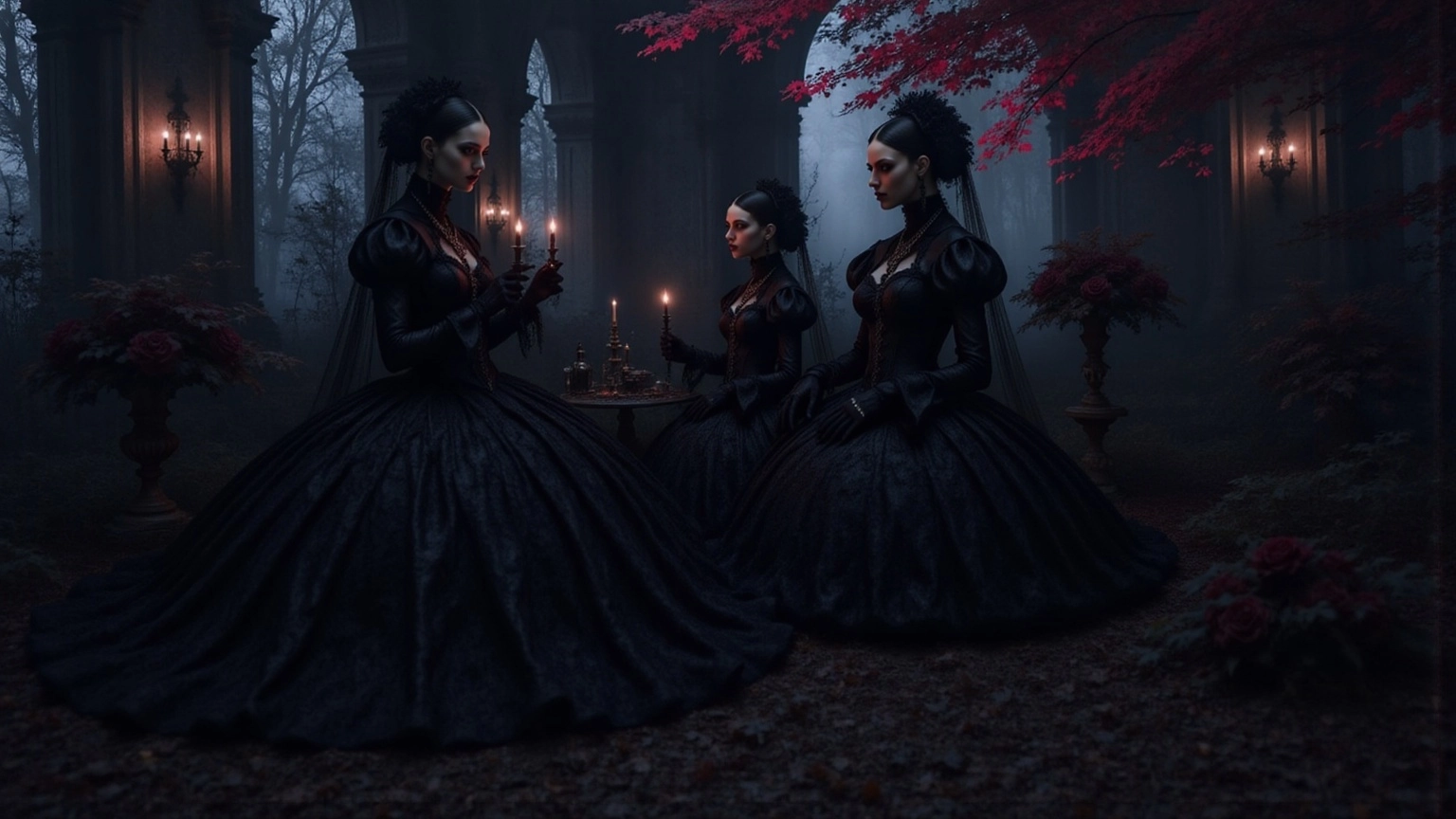
Siouxsie and the Banshees: Defining the Goth Sound
Emerging from the punk scene in the late '70s, Siouxsie and the Banshees didn’t just join the fray—they ignited a revolution that influenced many goth music bands. Their innovative melodies, haunting and raw, paired with Siouxsie Sioux's distinctive vocals, laid the very foundation for the genre's evolution. Albums like 'Juju' and 'A Kiss in the Dreamhouse' showcase their uncanny ability to fuse punk energy with dark themes, crafting atmospheric arrangements and reflective lyrics that resonate deeply with listeners.
This audacious blend didn't merely influence a few—it reshaped the landscape, marking Siouxsie and the Banshees as pioneers in artistic history. They contributed to the formation of dark culture, including the influence of goth music bands, a realm that continues to captivate. Yet, their journey is shrouded in controversy; allegations of racism tied to their debut single and Siouxsie's early stage outfits ignite discussions about the complexities of their legacy.
With 176 tracks ranked on their Best album, the band's prolific output stands as a testament to their indelible impact. As Siouxsie Sioux prepares to take the stage at the Latitude Festival on July 23, 2023, fans are drawn back to the emotional depths of their music. Particularly, the song 'Forever'—their saddest track—captures the melancholic essence that defines their work, inviting listeners to explore the shadows and light woven through their haunting melodies.
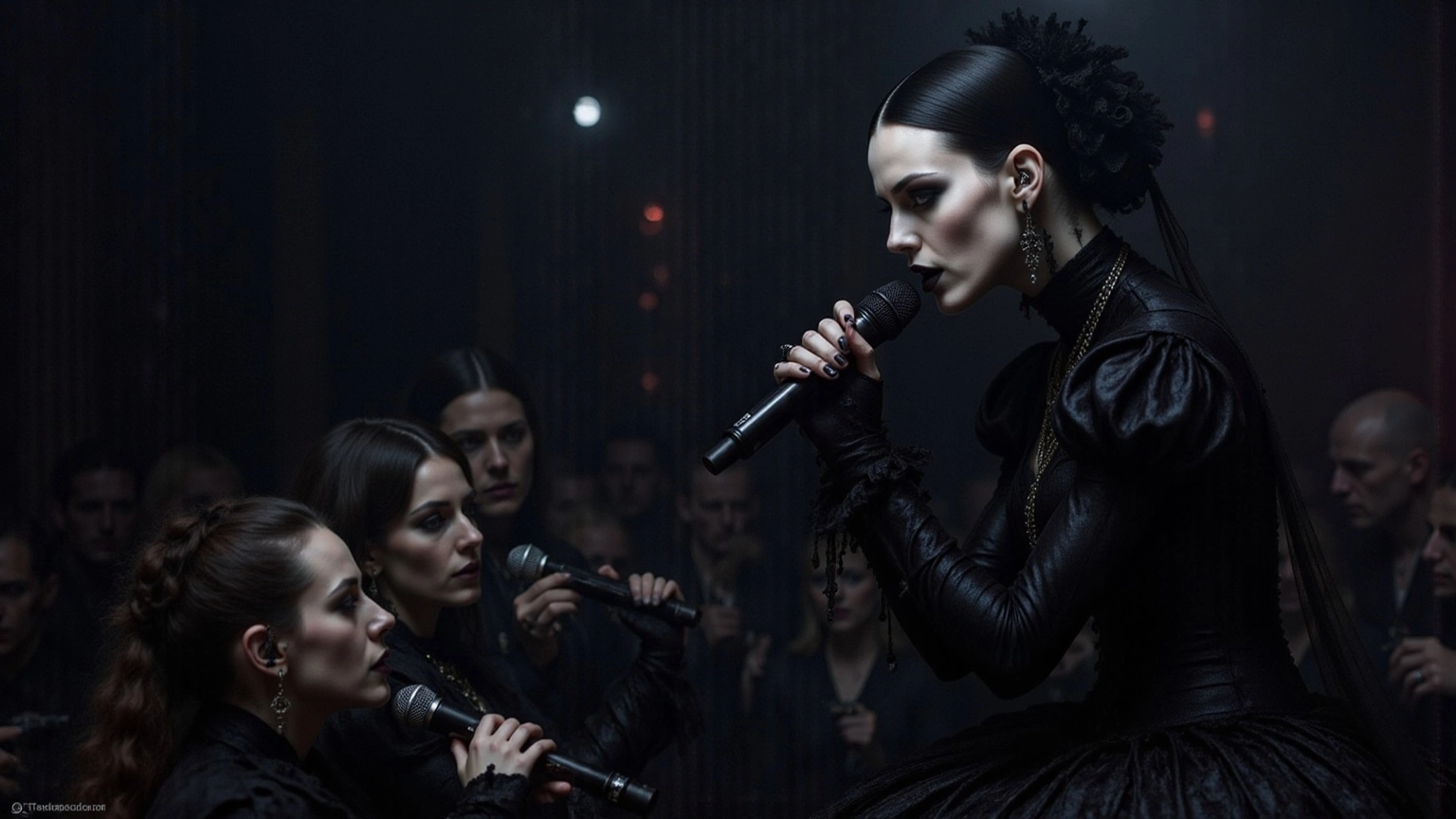
The Cure: Blending Post-Punk with Gothic Elements
The Cure, born in 1976, isn't just a band; they’re a haunting echo in the dark corridors of alternative music. With their signature blend of post-punk and shadowy elements, goth music bands have crafted a sound that resonates deeply within the hearts of those who dare to embrace the abyss. Albums like 'Disintegration' and 'Pornography' are more than music; they’re explorations of love, loss, and existential despair—each note reflecting the emotional essence of goth music bands.
'Disintegration' stands out, often hailed as their most profound and melancholic creation. Its haunting melodies and introspective lyrics linger, leaving an indelible mark on listeners and fellow artists alike. Robert Smith's iconic voice weaves through the atmospheric instrumentation, solidifying their status as a pivotal force in the genre.
But it’s not just about the sound; it’s about the emotional journey. The music of goth music bands reflects the raw struggles of human existence, serving as a powerful tool for emotional branding in lifestyle products. Fans, drawn to the gothic aesthetic, find solace in the intricate stories told by goth music bands that resonate with their own shadows.
With over 40 years in the game and 30 million albums sold, The Cure has mastered the art of weaving emotional narratives into their sound. They inspire a community that embraces the darker facets of life, nurturing creativity in countless artists. Their concerts, often stretching to 2.75 hours, are not merely performances; they’re immersive experiences, a testament to their unwavering commitment to their fans. Dive into the darkness, and let The Cure guide you through the labyrinth of emotion.
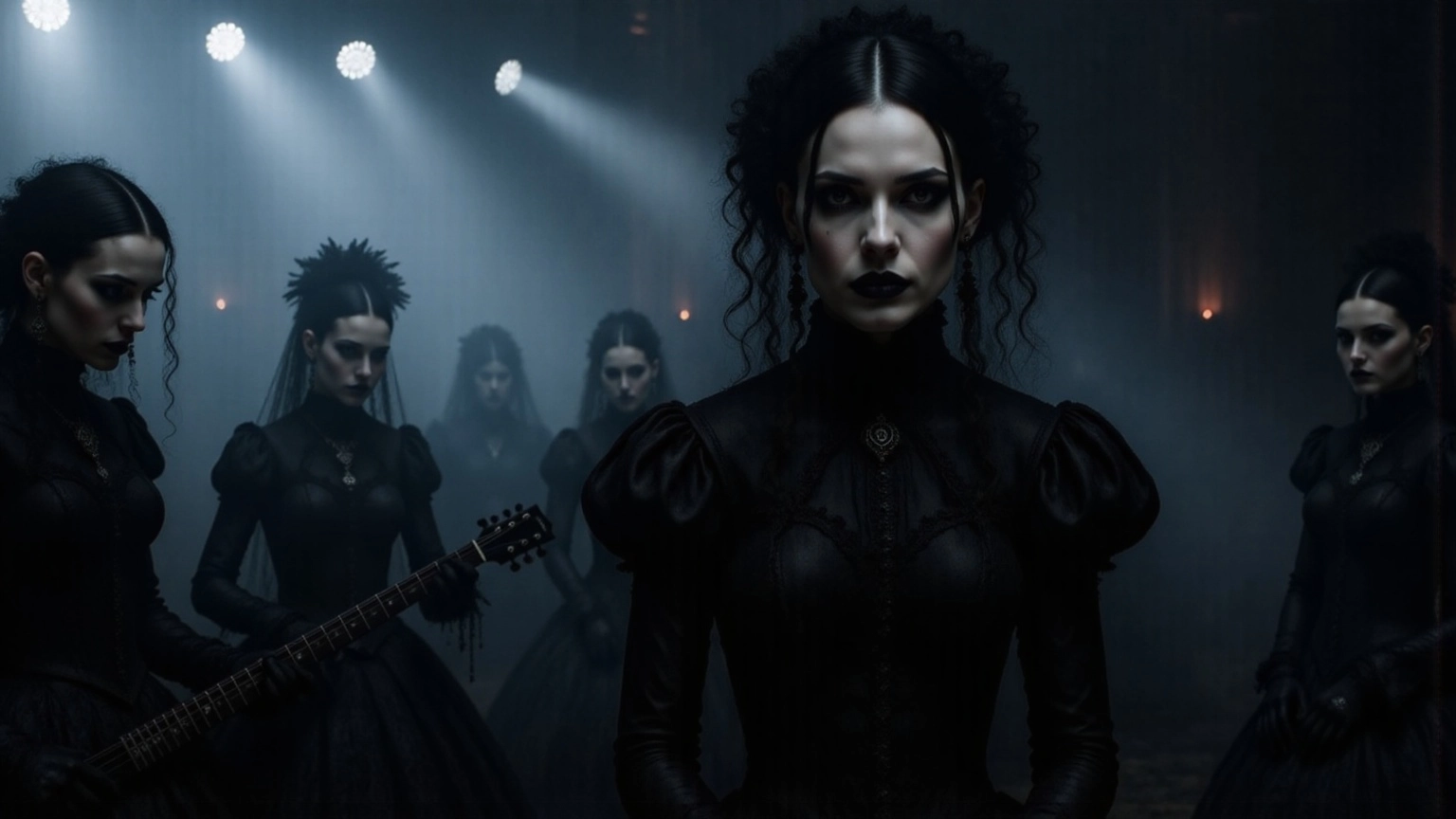
Joy Division: The Dark Atmosphere of Goth
Joy Division, born in 1976, stands as a shadowy pioneer of the dark genre, their sound a haunting echo of eerie melodies and reflective lyrics. Each note drips with atmospheric production, Ian Curtis's poignant vocals weaving a tapestry of melancholy that resonates deeply with the dark aesthetic. Their debut album, 'Unknown Pleasures', unleashed in 1979, features iconic tracks like 'Atmosphere' and 'Love Will Tear Us Apart'—anthems for those captivated by life’s darker corners, establishing Joy Division's legacy among goth music bands.
Ian Curtis once whispered, "Reality is only a dream, based on values and well worn principles, whereas the dream goes on forever," a testament to the emotional depth that permeates their lyrics, probing themes of despair and longing. This profound connection to the dark aesthetic not only sculpted the soundscape of the late 1970s but also laid the very foundation for goth music bands, influencing a myriad of genres and igniting inspiration in new generations of artists and listeners alike.
The original lineup—Ian Curtis, Bernard Sumner, Peter Hook, and Stephen Morris—crafted this legacy, solidifying Joy Division as an essential thread in the fabric of dark culture. What echoes in your mind when you think of their haunting melodies? Dive deeper into the abyss and discover the allure that continues to captivate souls.

Type O Negative: Gothic Metal with a Romantic Twist
Type O Negative, born in 1989, stands as a testament to the dark side of romance in music. Their signature sound—a haunting blend of deep, brooding vocals and heavy instrumentation—crafts an experience that lingers like smoke in the air. Tracks like 'Love You to Death' and 'Black No. 1' dive into love's complexities, loss, and existential despair, resonating with the gothic aesthetic and captivating metalheads alike. Their theatrical stage presence, paired with lyrical depth, cements their status as icons in the world of goth music bands and metal realms.
'Love You to Death' is a masterclass in romantic darkness, weaving devotion with melancholy. The lyrics pulse with longing and passion, revealing love’s shadowy depths that echo in the hearts of listeners. This exploration of romance, tinged with despair, has left an indelible mark on contemporary dark aesthetics, inspiring countless goth music bands to incorporate similar themes into their work.
But Type O Negative's influence stretches far beyond sound; they’ve reshaped the visual and cultural landscape of goth music bands within the dark genre. Their unique style—an intoxicating mix of elegance and darkness—has etched a lasting impression on modern dark culture. They continue to inspire new generations of artists and enthusiasts, ensuring their legacy thrives in the ever-evolving world of dark sound.
With a social media following of 1,581,555, Type O Negative's reach is undeniable, echoing through cities like Warsaw, São Paulo, and Los Angeles, where listener counts stand at 36,399, 37,215, and 29,119, respectively. Their sound resonates not just with the dark lifestyle but also aligns with wellness concepts championed by brands like Darc Arts, highlighting the therapeutic benefits of THCA. As cannabis enthusiasts delve into the intersection of sound and wellness, the romantic themes in Type O Negative's work serve as a haunting reminder of the profound connections between art, emotion, and the dark experience.
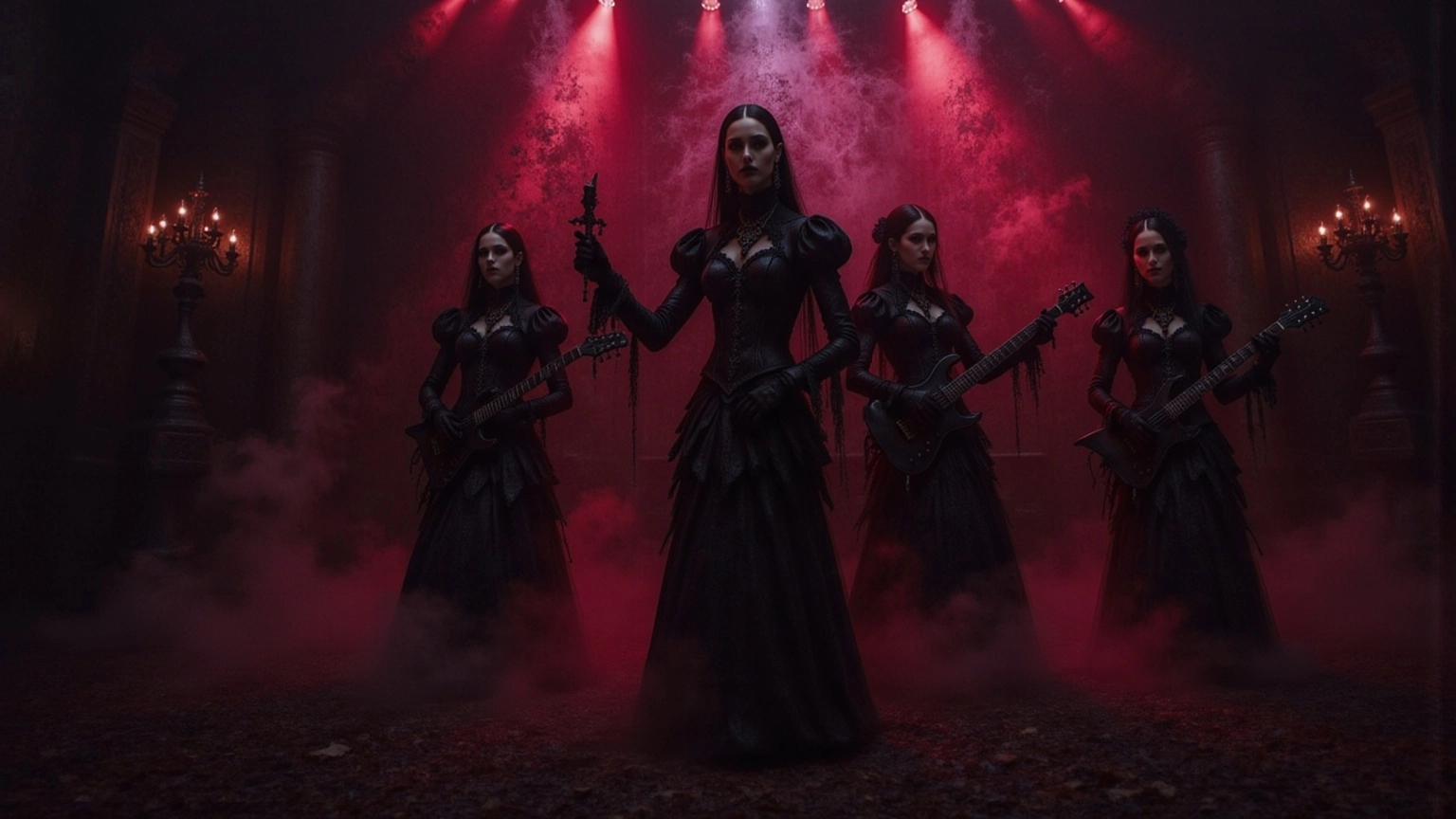
The Sisters of Mercy: Brooding Icons of Goth
The Sisters of Mercy, born in 1980, are considered one of the dark architects of gothic rock, influencing many goth music bands. Their sound—a haunting blend of gothic and hard rock—echoes with Andrew Eldritch's resonant vocals and atmospheric instrumentation. It's a sound that doesn't just resonate; it reverberates through the very fabric of the genre. Tracks like 'Temple of Love' and 'This Corrosion' are not merely songs; they are anthems that pulse with life, capturing the hearts of the dark community and solidifying their status as icons.
Decades into their legacy, The Sisters of Mercy have sculpted not just the sound of the dark genre but have also influenced its very branding, inspiring countless goth music bands and fans. They delve into the depths of love, loss, and existential angst, weaving narratives that linger in the shadows, securing their place as a cornerstone of the subculture's identity. Are you ready to embrace the darkness they embody? Dive deeper into the gothic realm and discover the haunting beauty that awaits.
![]()
Dead Can Dance: Ethereal Sounds in Goth Music
Dead Can Dance, born in 1981, is a sonic alchemist, weaving together gothic rock, global rhythms, and neoclassical threads into an ethereal tapestry, similar to the works of various goth music bands. The haunting vocals of goth music bands dance with complex instrumentation, conjuring a mystical atmosphere that resonates with the very essence of the goth aesthetic.
As Peter Ulrich muses in his memoir, their sound cultivates a profound emotional connection, declaring, "The deep emotional bond their compositions have with fans is what keeps it alive."
Albums like 'Within the Realm of a Dying Sun' and 'Aion' are not just records; they are portals, transporting listeners to otherworldly realms where emotions run deep. Their art is a labyrinth of existential and spiritual motifs, solidifying their role as a pivotal influence in the rock genre.
By merging diverse musical traditions, goth music bands don’t just enhance their sound—they redefine the ethereal and dark soundscape, inspiring countless artists and shaping the very legacy of goth music.
So, are you ready to dive into this hauntingly beautiful world?

Fields of the Nephilim: Atmospheric Gothic Imagery
Fields of the Nephilim, born in 1984, are legends in the atmospheric soundscape, weaving dark rock, heavy metal, and psychedelic threads into a haunting tapestry. Their music? A siren’s call of evocative melodies and lyrical poetry that plunge into the depths of mythology and the occult—echoes of a dark aesthetic rising from the ashes of British punk.
Tracks like 'Moonchild' and 'Last Exit for the Lost' are not just songs; they’re experiences. 'Moonchild' dances with transformation and mystique, while 'Last Exit for the Lost' grips you with existential despair. This isn’t mere music; it’s a journey through shadowy realms, where mythological motifs enrich their lyrical complexity, cementing goth music bands as pivotal architects of the dark and metal genres.
Their influence? Profound. They inspire countless artists, leaving a legacy that reverberates through the artistic scene. And let’s not forget the striking visual style and performances of goth music bands—each a reflection of the motifs of shadow, death, and solitude, resonating deeply with an audience hungry for connection in the dark.
So, are you ready to delve deeper into this gothic abyss? The allure of Fields of the Nephilim awaits, challenging your perceptions and inviting you to explore the shadows of sound.
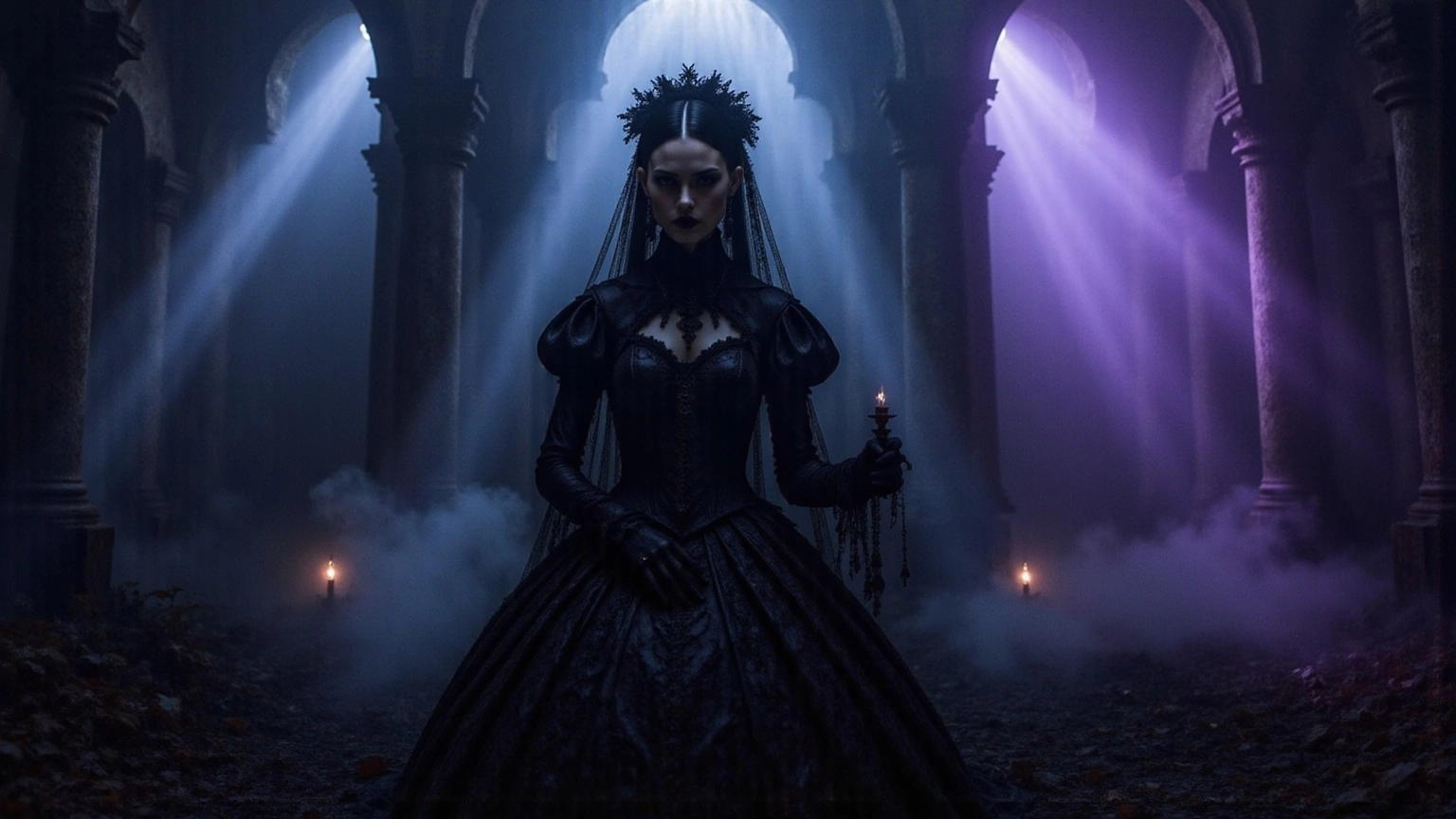
Christian Death: Provocative Pioneers of Deathrock
Christian Death, birthed in October 1979 by the audacious guitarist John 'Jay' Albert, the haunting vocalist Rozz Williams, bassist James McGearty, and drummer George Belanger, stands as a titan in the deathrock and gothic realms. Their provocative style and confrontational lyrics slice through societal norms, daring to delve into the shadows of death, religion, and sexuality. Albums like 'Only Theatre of Pain' and 'Catastrophe Ballet' resonate like echoes in a crypt, leaving an indelible mark on the goth scene and influencing a legion of goth music bands, including Type O Negative and Marilyn Manson, cementing their status as icons of the genre.
The debut album, 'Only Theatre of Pain,' is a dark jewel, exploring bleak and anti-Christian themes that resonate with those yearning for a deeper connection to the abyss. This album laid the groundwork for the deathrock movement, a unique concoction of punk, post-punk, and gothic elements. Their lyrics, provocative and raw, ignited discussions on taboo subjects, pushing the boundaries of what songs could express. As Rozz Williams poignantly remarked, "For me, Christian Death was never the same without Rozz’s unique voice," a testament to the band's haunting influence.
Yet, Christian Death's legacy transcends mere sound; they have stirred societal conversations within the goth genre, inspiring various goth music bands such as Type O Negative and Marilyn Manson, who have drawn from their rich lyrical tapestry. Critics have hailed their music for its slow, doomy guitar riffs and ambient horror-soundtrack synths, crafting an atmosphere that beckons listeners to confront their innermost fears and desires.
The essence of Christian Death lies in their ability to weave intricate narratives that reflect the human condition, transforming them from mere musicians into cultural commentators. Their work continues to resonate, inviting new generations to plunge into the provocative themes that define the gothic experience often explored by goth music bands.
![]()
Conclusion
The legacy of iconic goth music bands has carved a haunting path through both genre and culture. These artists didn’t just define the sound of goth; they conjured an aesthetic that dares listeners to wander into darker realms. From Bauhaus’s shadowy influence to the ethereal soundscapes of Dead Can Dance, each band weaves a distinct thread into the rich tapestry of gothic music.
Consider this:
- Bauhaus stands as the cornerstone of gothic rock,
- Siouxsie and the Banshees shattered conventions with their groundbreaking style.
- The Cure and Joy Division embody emotional depth, their atmospheric resonance echoing the very essence of goth.
- Type O Negative and Christian Death infuse romance and provocation, deepening the narrative of dark culture.
Together, these bands don’t just shape music; they redefine fashion, art, and lifestyle, nurturing a vibrant community that thrives on creative expression.
As the goth genre morphs, it remains an unyielding vessel for emotional exploration and identity. The enduring legacy of these bands underscores music's power to stir emotions, challenge societal norms, and forge connections. Embrace the allure of goth culture—dare to dive into its depths, celebrating the beauty found in shadows and the artistry that defines this singular genre.
Frequently Asked Questions
What is Darc Arts and what does it offer?
Darc Arts is a brand that merges cannabis culture with gothic elegance, offering premium THCA products that reflect a sophisticated and artistic lifestyle.
What is THCA and why is it significant in the cannabis market?
THCA, or tetrahydrocannabinolic acid, is a non-psychoactive compound found in cannabis. Its significance is growing as the global cannabis market is projected to reach USD 65.54 billion by 2032, with an increasing demand for high-quality cannabis products.
How does Darc Arts differentiate itself in the cannabis market?
Darc Arts stands out through its unwavering commitment to quality and its unique branding that resonates with the gothic spirit, appealing to niche markets and enthusiasts who seek a deeper connection between cannabis and dark aesthetics.
What role did Bauhaus play in shaping goth music and culture?
Bauhaus, formed in 1978, is considered a foundational goth music band. Their iconic track 'Bela Lugosi's Dead' is often regarded as the beginning of gothic rock, influencing numerous goth music bands and shaping the aesthetics of fashion and visual art within the goth subculture.
How did Siouxsie and the Banshees contribute to the goth music genre?
Siouxsie and the Banshees emerged from the punk scene in the late '70s and created innovative melodies and dark themes that laid the groundwork for the evolution of the goth genre, significantly influencing many goth music bands.
What is the legacy of Bauhaus in relation to modern brands like Darc Arts?
Bauhaus's impact on music and visual art has influenced the aesthetics and branding of contemporary brands like Darc Arts, which draw from Bauhaus's artistic ethos to create a unique narrative that resonates with enthusiasts of dark culture.
What controversies surround Siouxsie and the Banshees?
Siouxsie and the Banshees have faced controversies, including allegations of racism related to their debut single and Siouxsie's early stage outfits, sparking discussions about the complexities of their legacy in the music scene.
What is the significance of the song 'Forever' by Siouxsie and the Banshees?
'Forever' is considered one of Siouxsie and the Banshees' saddest tracks, capturing the melancholic essence of their music and inviting listeners to explore the emotional depths present in their work.
